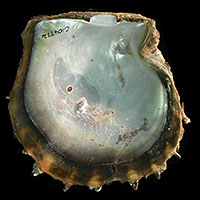|
< Previous family introduction |
|
|||||
 |
Family Margaritidae Pearl Oysters
|
|||||
|
The pearl oysters of the genus Pinctada were previously placed in the family Pteriidae along with the genus Pteria, but Huber (2015) considered them to differ so much from the genus Pteria that he removed them to the family Margaritidae. This has left the Pteriidae with only the genera Pteria and Pterelectroma. Margaritidae itself contains only the genus Pinctada, with 21 currently recognised species. The species are highly variable, and there are many synonyms. Shells of Margaritidae are large, up to 335 mm in length, but the NSW species do not exceed 110 mm. Most species are found in the Indo-West Pacific Ocean, with a few in the Atlantic and eastern Pacific. They live in the intertidal and shallow subtidal, attached by a byssus to rocks, corals, or seagrasses. All the NSW species live on rocky shores, and more commonly in muddy, sheltered habitats. As with other bivalves, they are filter feeders, taking in water that passes over the gills for extraction of oxygen and food collection. Pearl oyster shells have been collected in Australia for mother-of-pearl products, including buttons, from the 1860s. The Golden-lip Pearl Shell, Pinctada maxima, was the basis of the fishery around Broome, and Pinctada albina was collected in Shark Bay, WA. Other species, particularly Pinctada margaritifera, the Black-lip Pearl Shell, were fished around northern Australia, particularly in Torres Strait. As described under Pinctada fucata, pearl oysters are presently farmed in Broken Bay, NSW, for cultured pearl production. Family references Hynd, J.S. (1954) A Revision of the Australian pearl-shells, genus Pinctada (Lamellibranchia). Australian Journal of Marine and Freshwater Research 6(1): 98-137. Landman, N.H., Mikkelsen, P.M., Bieler, R. & Bronson, B. (2001) Pearls: a Natural History Harry N. Abrams, New York. Coverage All species recorded from NSW are detailed here. There could be fewer than seven species in NSW, but not more. Two species are moderately common in NSW, whereas the others are rare and occur only in the north of the state. Identification notes The pearl oysters are flat and thin shelled, with the left valve slightly more inflated than the right valve. The right valve bears a deep byssal notch through which the byssus protrudes. The dorsal margin is straight, with an external ligament, and no true teeth. Juveniles are more oblique than adults. The exterior sculpture varies from almost smooth to strongly rugose with foliaceous laminae in some species. It is difficult to identify individual specimens, as the shape, colour and sculpture varies considerably within a species. To positively identify specimens, a group of 10 or more shells is needed to take into account the variations within a species.
|